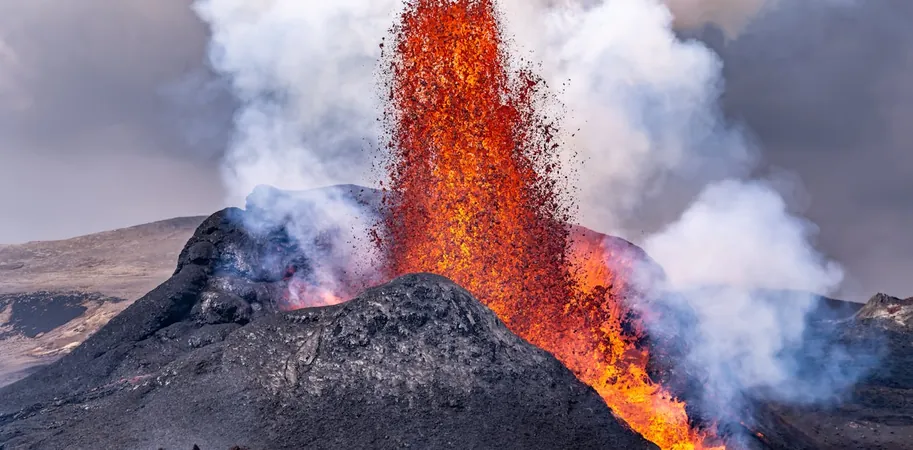
Is It a Volcanic Eruption or a Meteorite Impact? New Discoveries Change the Narrative on Greenland's Ancient Climate Mystery
2025-09-18
Author: Wei Ling
Unearthing Secrets Beneath Greenland's Ice Sheet
In the heart of Greenland's ice sheet, researchers have stumbled upon a shocking chemical signature—a dramatic spike in platinum levels from 12,800 years ago—fueling a fiery debate among scientists. While some believe this precious metal indicates a celestial collision, new research suggests a much more terrestrial explanation: a volcanic eruption in Iceland.
The Younger Dryas: A Chilling Climate Paradigm Shift
This platinum spike syncs astonishingly well with the onset of the Younger Dryas, a period characterized by drastic temperature drops across the Northern Hemisphere. What caused this sudden freeze after a warming trend? Understanding this could unlock clues about our planet’s climate future.
Debunking the Meteorite Theory
Traditionally, scientists indicated that freshwater pulses from melting North American ice sheets triggered disruptions in ocean circulation, leading to cooling. Others claim it was space debris crashing into our planet. However, scientists have raised eyebrows at these theories, pointing instead to volcanic activity.
Digging for Answers: Research and Discoveries
In a groundbreaking study, researchers analyzed ice core samples from the Greenland Ice Sheet and interrogated previous findings of high platinum levels. What did they discover? These platinum readings were markedly different from those found in known meteorites, and they were absent from samples associated with other significant eruptions like Germany’s Laacher See.
After thorough sampling of pumice from Laacher See, which erupted around the same time, results showed virtually no platinum, suggesting it couldn't be the source of Greenland's mysterious spike.
Timing Is Everything: The Platinum Mystery Unraveled
Upon closer examination of the timelines, researchers found that the platinum spike actually occurred about 45 years after the Younger Dryas began—too late to be a trigger for the event. This finding, coupled with the duration of the spike lasting over 14 years, indicates it stemmed from a prolonged volcanic activity rather than a sudden impact.
The Icelandic Connection: Volcanic Activity as the Main Culprit
The chemical composition of the platinum spike bore resemblance to volcanic gas remnants from submarine volcanoes, particularly those in Iceland. Eruptions here can last for years, aligning perfectly with the observed platinum spike duration. The interplay of volcanic gases and surrounding water may account for the peculiar geochemistry observed.
Linking Past and Future Climatic Events
This research doesn’t just rewrite history—it offers critical insight into future climate scenarios. Historical volcanic eruptions have the power to cool the Earth by releasing sulfur particles that reflect sunlight. As the planet was already teetering between warm and cold phases, volcanic activity around the time of the Younger Dryas could have been the tipping point.
Conclusion: Why This Matters?
While the study centered on the platinum spike, it also sheds light on the need for further investigation into climate triggers. Understanding how Earth reacted in the past is vital as we brace for the next inevitable large-scale event, whether it be a meteor shower or a volcanic eruption.
The clues hidden in Greenland’s ice could be the key to unlocking the future of our climate. The truth may not lie in outer space, but right beneath our feet.

 Brasil (PT)
Brasil (PT)
 Canada (EN)
Canada (EN)
 Chile (ES)
Chile (ES)
 Česko (CS)
Česko (CS)
 대한민국 (KO)
대한민국 (KO)
 España (ES)
España (ES)
 France (FR)
France (FR)
 Hong Kong (EN)
Hong Kong (EN)
 Italia (IT)
Italia (IT)
 日本 (JA)
日本 (JA)
 Magyarország (HU)
Magyarország (HU)
 Norge (NO)
Norge (NO)
 Polska (PL)
Polska (PL)
 Schweiz (DE)
Schweiz (DE)
 Singapore (EN)
Singapore (EN)
 Sverige (SV)
Sverige (SV)
 Suomi (FI)
Suomi (FI)
 Türkiye (TR)
Türkiye (TR)
 الإمارات العربية المتحدة (AR)
الإمارات العربية المتحدة (AR)